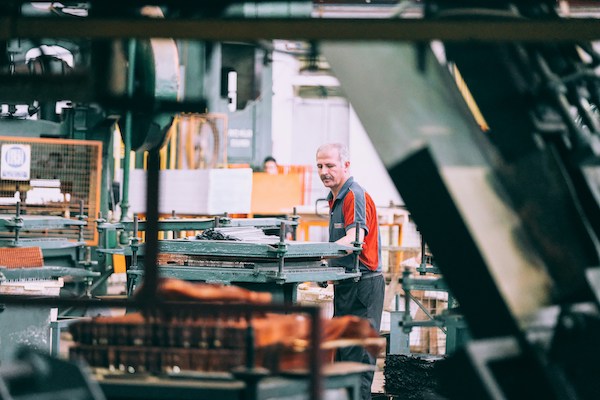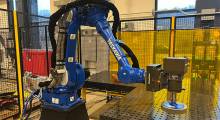The rapid advancement of robotic metal stamping opens many new possibilities for manufacturers. Whether plant managers want to make their inspection processes more efficient or get real-time defect alerts to minimize material loss, almost anything is possible with high-precision technology like this.
Why Manufacturers Adopt Robotic Metal Stamping
Robotic metal stamping is rapidly becoming an industry standard addition to plant floors. Facilities can use it for various applications like sheet unstacking or die inspection. In comparison to traditional methods, it has enhanced flexibility and a wider range of benefits.
Toni Roda — global product manager at ABB — discussed the biggest problems in the sector, stating, “Many stamping companies are looking to implement some form of robotic automation but are unsure of where to start.” After all, manufacturers have to balance speed with accuracy.
While traditional automation tools dramatically improve production rates, they’re vulnerable to slight miscalculations. If they falter during complex stamping, they waste valuable time and material. Above all else, this technology must ensure precision.
Although robotic metal stamping has existed for ages, many of the most significant innovations are relatively recent. The progress shouldn’t come as a surprise to anyone, considering the industry’s market value reached $212 billion in 2022.
The Precision of Robotic Metal Stamping
Robotic metal stamping combines high performance and standards to produce better products at a lower price. Clever system designs and innovative digital integrations have become standard as the technology has advanced. Now, manufacturers can use these tools in every process, from quality assurance to press tending.
For one, robotic metal stamping technology can reduce overhead expenses dramatically. Multiple in-die sensors equipped with artificial intelligence can detect and report defects immediately, preventing material waste. Since inconsistencies of an imperfect die raise production costs substantially over time, an automated system with instant feedback is an ideal solution.
Although in-die sensing initially came to exist as a solution to die crashing, manufacturers soon realized it could evolve into something more. Now, it can monitor various metal stamping processes with extreme precision. For example, analog-output proximity sensors can measure materials as thin as 0.04 inches wide.
Collaborative robots can also make manufacturing plants much safer. Previously, original designs were complex and required special knowledge to operate. Now, people can work right next to them on the production floor without special safety equipment.
Manufacturing professionals experience substantial operating condition improvements when these machines take over dangerous, uncomfortable jobs. For example, workers receive 80% less exposure to high temperatures when they use robots during residue-cleaning maintenance cycles.
The Role of Traditional Technology
Many manufacturers have hesitated to adopt robotic metal stamping technology because it traditionally requires a hefty upfront investment. Additionally, programming was often time consuming and resulted in costly downtime. However, companies have been working hard to find solutions to common pain points.
Manufacturing plant managers have also been reluctant to adopt robotic metal stamping tools because they’re bulky. Admittedly, managing worker safety and product quality is more challenging when autonomous machinery takes up most of the production floor. However, collaborative technology now allows professionals to work with them instead of around them.
Yaskawa’s collaborative robot — the Smart Pendant — is a fantastic example of this new technology. Its patented system design allows it to move in relation to the person controlling it, meaning manufacturing professionals can adjust its position in real time however they want.
How Metal Stamping Robotics Have Advanced
Companies are hard at work to revolutionize robotic metal-stamping technology. For example, Machina Labs harnessed the power of AI to address machine-induced inconsistency. The new tool will use multiple in-die, algorithm-powered sensors to mold sheets precisely. Every time it finishes, it creates a digital twin so plant managers can quickly inspect and review its precision.
Mohamed (Sid) Siddeek — the Corporate Vice President and Head of NVentures — said the robot’s advanced computing technology “...enables companies to operate manufacturing facilities with substantially improved efficiency and broadened capabilities.”
Aside from technological integrations, organizations have also focused on improving general efficiency. For example, ABB created the IRB 760PT for material handling and press tending. Its cycle times are 25% faster than linear automation systems and it can securely lift nearly 1,000 pounds. This robot operates at a much higher capacity than humans can, and yet it doesn’t experience a single drop in productivity or accuracy.
The Evolution of Robotic Metal Stamping
Although many manufacturers have hesitated to adopt robotic metal stamping technology because of its past flaws, it has dramatically advanced in recent years. Modern metal-stamping robots can be rapidly reprogrammed, moved around the production floor and combined with the latest digital innovations. Over time, there’s no telling how this sector could evolve — and what opportunities it could provide.
About the Author

Emily Newton is a tech writer who enjoys writing about the latest innovations changing our world. Read more of her articles online at Revolutionized Magazine.
Article topics
Email Sign Up
















